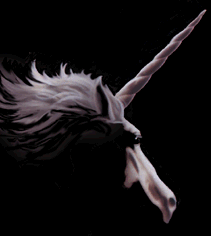Unicorns
A particularly beautiful creature once widespread throughout the northern hemisphere. Known under different names in different countries, but now popularly known by its Latin appelation deriving from unus=one, cornus=horn. The Unicornus sinoensis roamed the forests of China, Japan and Indonesia; the Unicornis carcadan was found throughout Arabia, India, North Africa, and much of the Middle East; the Unicornis europa lived in most European countries; and the Unicornis alba was native to the British Isles.
Generally the unicorn was a solitary creature. Unlike other hooved animals it did not pasture in herds but walked alone, and after the male and female unicorn had come together for mating the male would resume its solitary habit. A unicorn colt, which was born without a horn, stayed with its mother until the horn had grown to full length and then went off on its own.

The different varieties of unicorn had specific variations in appearence, but all had the head and body of a horse, the legs of an antelope, the tail of a horse or a lion, and the beard of a goat. The dominant distinguising feature was the long, sharp, twisted horn growing from the middle of its forehead.
This horn was a fearsome weapon, especially since the unicorn was a very fierce and aggressive animal which could run faster than any other creature of the plains and forests. Adult unicorns protected their territory with single-minded fury. Even an elephant would steer clear of a unicorn. Lions, being carnivores, often lived amicably in unicorn territory since the two animals did not threaten each other's food supplies, and a lion never attacked a unicorn for fear of its great horn.
Unfortunately for unicorns, men descovered that their horns were absolute proof against poision. If poisioned wine was poured into a drinking-cup fashioned from unicorn horn (or unihorn) the poison became innocuous. Plates and serving instruments made from unicorn rendered poisioned food quite harmless to the consumer. The rulers of the ancient world, who lived under constant threat of poisioning by their subjects or relations, paid great sums for unihorn and hunters risked their lives to supply them.
Unicorns moved so fast and were so intelligent that it was impossible to kill them with a bow or a spear or to lure them into traps, and so the hunters developed a dangerous technique. When a hunter saw a unicorn he stood in front of a tree, and when the unicorn charged him he dodged quickly aside. The tremendous force of a unicorn's charge drove its horn deep into the tree, and held it fast so that it might be killed.
Many hunters misjudged the speed of a charging unicorn and were transfixed to trees, but profits from unicorn-hunting were so high that the dangerous practise continued until one of the hunters happened to take his virgin daughter on a hunting expedition. To his astonishment a unicorn trotted out of the forest and approached her with such affection that she was able to hold his head in her lap. It lay there unresisting while the hunter sawed off its precious horn.
After that, virgins were in great demand as unicorn lures. Unicorns seemed to feel that the loss of a horn was a small price to pay for virginial embraces. The inevitable result was that when the virgins released them again they had no weapon against predators, and the entire unicorn family eventually became extinct.
Abada | Myths and Legends
Abath | Myths and Legends
A'nasa | Myths and Legends
Giant Without a Name | The Legend of King Arthur
